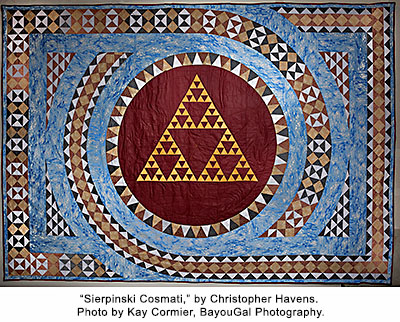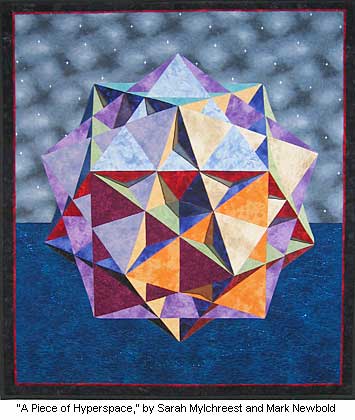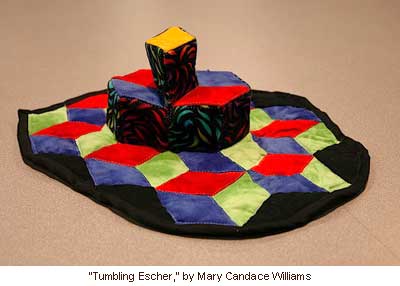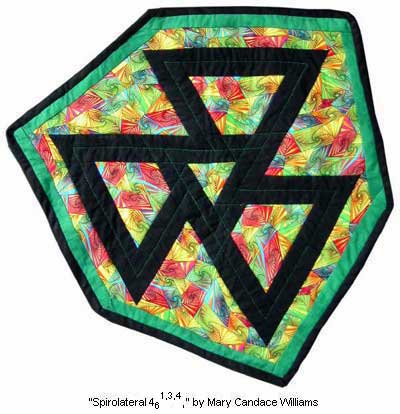
Mathematical ImageryMathematical artists create strong, stunning works in all media and explore the visualization of mathematics
Quilts :: Multiple Artists
Many quilts show mathematical shapes both simple and complex. "I am a mathematical artist trying to give mathematical concepts a visual counterpart that everyone can enjoy," says Mary Candace Williams.

This is a hyperbolic design so it is as if a sphere was mapped onto a plane. The printed fabric has distorted spheres. This quilt is unusual in that it is pieced from the outside to the center. Quilt copyright 2005 Mary Candace Williams; photograph by Robert Fathauer. -- Mary Candace Williams

Quilt, 12 x 8.5'. This work, "Sierpinski Cosmati," is a recreation of a Sierpinski triangle recently found in friezes in medieval cloisters. Christopher Havens created this quilt while in prison in Washington State. Photo by Kay Cormier, BayouGal Photography.

The quilt depicts a polyhedron known as the Great Triambic Icosidodecahedron. It was paper-pieced by Sarah Mylchreest from a design generated by Mark Newbold using his "Hyperspace Star Polytope Slicer" Java applet. It won a ribbon in the 2002 Vermont Quilt Festival. See DogfeathersM for a description of the quilt pattern. Photograph and image copyright 2005 by Mark Newbold. --- Sarah Mylchreest

In order to keep the möbius as a band, I used only the eleven symmetries that are not based on a hexagon. The fabric was chosen for its mathematical content. Quilt by Mary Candace Williams; photograph by Annette Emerson. --- Mary Candace Williams

This quilt is is the third in a series of quilts based on the approximation of a parabola by drawing a series of straight lines. There were eight divisions of the original block which was then mapped onto a rhombus and repeated eight times for the complete quilt. The star part of the design was enhanced by the use of shades of color. Quilt copyright 2003 Mary Candace Williams; photograph by Robert Fathauer. --- Mary Candace Williams

If you look at the quilt at a perpendicular angle you have a traditional diamond tessellation known as Tumbling Block. From the side, however, it rises up and back into the quilt; thus a nod to Escher's "Reptiles" in which the drawn lizard rises up and out and back into the drawing board. Quilt copyright 2006 By Mary Candace Williams; photograph by Annette Emerson. --- Mary Candace Williams

The challenge of doing a quilt that has only rotational symmetry and uncommon angles lies in a technique called partial seaming. The printed fabric has a lot of pursuit curves overlaide on top of one another and shows a lot of contrast with the black of the spirolateral. Quilt copyright 2005 Mary Candace Williams; design is copyright Robert Krawczyk; photograph by Robert Fathauer. --- Mary Candace Williams



